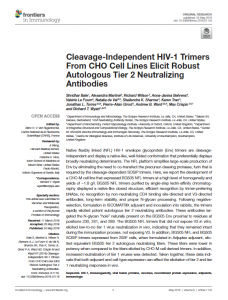As a child growing up in Nigeria, I had first-hand experience of the suffering caused by debilitating diseases such as malaria. This fueled my interest in the life sciences and passion to positively impact human health by combating diseases of high unmet medical need, particularly in developing countries. Today, Nigeria has the second highest burden of HIV in the world and one of the highest rates of new infections in sub-Saharan Africa.[1]
A vaccine against the HIV virus remains a vital global public health need and is a major challenge for researchers and industry.
When most people think about vaccines, they likely assume that developing safe and effective vaccines is simple and straightforward given their wide use and because they’ve been “around” for decades. Unfortunately, the path to commercial vaccine availability is often rife with challenges, particularly in two main areas:
- Identification of a candidate immunogen(s) (i.e., an antigen or substance that may be specifically bound by components of the immune system) that can induce a sustainable and robust immune response in the body, and
- Development of a scalable production process to generate clinical products of high quality.
The development of recombinant (genetically modified) vaccines offers a promising way to overcome these challenges. In fact, recombinant protein vaccines are an important weapon in the arsenal for prevention of infection and the spread of infectious diseases:
- They are safer than other vaccine types, such as live/attenuated or inactivated/killed vaccines,
- They can be very effective with the appropriate adjuvant (i.e., a mechanism used to enhance the efficacy of a vaccine by helping to boost the immune response), and
- They can be scaled up in an efficient and cost-effective manner.
The success of recombinant protein vaccines is critically dependent upon production of immunogens that mimic what is found in infectious organisms. In other words, the recombinant protein vaccines must be properly folded and contain the correct modifications, such as glycosylation. This approach maximizes the odds for an immune response that generates antibodies that block or neutralize the infectious agent. The very best immunogens for this task are often attained via production in Chinese hamster ovary (CHO) cells.
The International AIDS Vaccine Initiative (IAVI) is a non-profit scientific organization dedicated to discovering and developing a vaccine for HIV/AIDS through several approaches, including the development of recombinant protein vaccines targeting the HIV-1 Env protein complex. In 2016, Selexis established a collaboration with IAVI to generate stable, high-production CHO cell lines expressing properly folded HIV-1 Env trimers. These trimers can be difficult to express in a properly folded state, and to date, protein expression levels have been relatively low. However, through this collaboration, we have been able to achieve viable production levels through the implementation of two key technological approaches: the assembly of Env gp120 and gp41 proteins into more stable heterodimeric trimers and the utilization of modules from the Selexis’ SUREtechnology Platform™ and Selexis’ SURE CHO-Mplus Libraries™ to boost expression levels and drive more robust and effective folding, as well as the assembly and maturation of the HIV-1 Env trimer antigens through the secretory pathway of the production cell lines.
 Empirically, the SURE CHO-Mplus Libraries have been shown to significantly improve production levels of a broad range of proteins including difficult-to-express monoclonal antibodies, enzymes, structural proteins and fusion proteins. Through Selexis’ modular technology approach, researchers were successful in generating three high-production CHO cell lines for three different designs based on the HIV Env.
Empirically, the SURE CHO-Mplus Libraries have been shown to significantly improve production levels of a broad range of proteins including difficult-to-express monoclonal antibodies, enzymes, structural proteins and fusion proteins. Through Selexis’ modular technology approach, researchers were successful in generating three high-production CHO cell lines for three different designs based on the HIV Env.
Selexis and IAVI remain committed to expediting the manufacture of engineered HIV envelope proteins. In May 2018, Selexis, IAVI and collaborators announced the publication of their work in Frontiers in Immunology highlighting their improved approach for the production of HIV vaccines.
Analysis of the HIV-1 Env trimers determined that they were properly glycosylated and that 90% of the produced trimers contained the closed, native-like conformation structure. The trimers were stable at 4oC for at least two months. Most significantly, these trimers displayed favorable immunogenic properties, including eliciting robust neutralizing antibodies. This approach is now being applied to Env trimers from other HIV clades.
I am proud of our work with IAVI and its other research partners in advancing the product development of a vaccine that addresses one of the most pressing infectious disease issues of our time. These cutting-edge researchers intend to keep pushing the envelope on what is possible with vaccine development.


 Empirically, the SURE CHO-Mplus Libraries have been shown to significantly improve production levels of a broad range of proteins including difficult-to-express monoclonal antibodies, enzymes, structural proteins and fusion proteins. Through Selexis’ modular technology approach, researchers were successful in generating three high-production CHO cell lines for three different designs based on the HIV Env.
Empirically, the SURE CHO-Mplus Libraries have been shown to significantly improve production levels of a broad range of proteins including difficult-to-express monoclonal antibodies, enzymes, structural proteins and fusion proteins. Through Selexis’ modular technology approach, researchers were successful in generating three high-production CHO cell lines for three different designs based on the HIV Env.